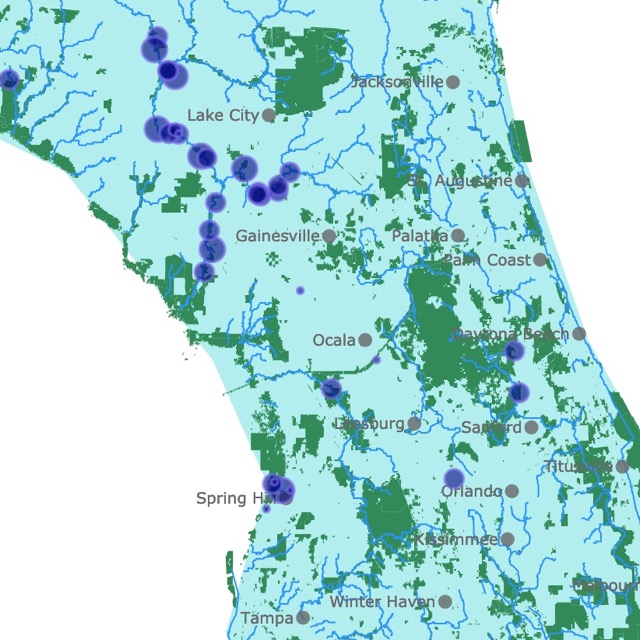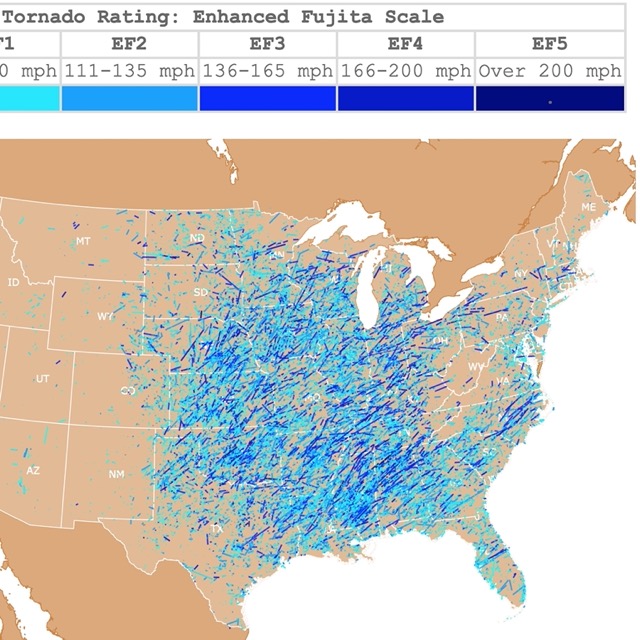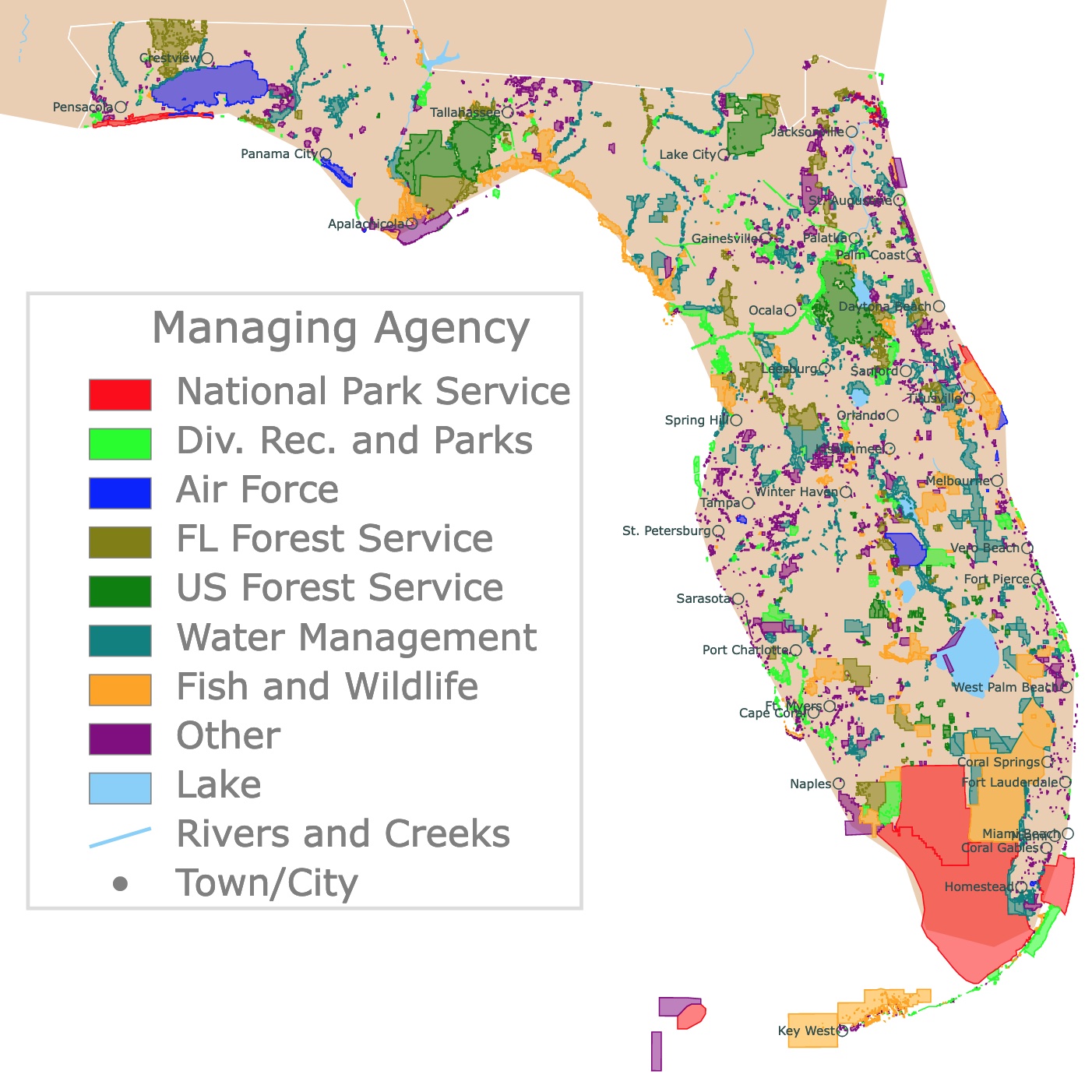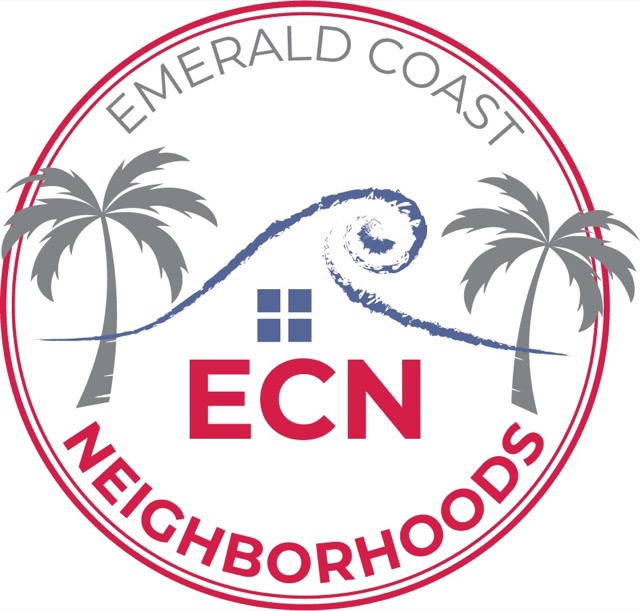Map of Florida's Parks
This interactive map shows the Locations, Names, Areas, and Details of National Parks, State Parks, National Forests, State Forests, and other Public Lands of Florida. It also shows major cities and rivers for context. For more detail, zoom in. For more information, hover over the map, or scroll down.
Florida's Geography
The Sunshine State is a peninsula that is mainly surrounded by water. To the east, it borders the Atlantic Ocean and the Gulf of Mexico to the south. To the north, it shares borders with Georgia and to the west with Alabama.
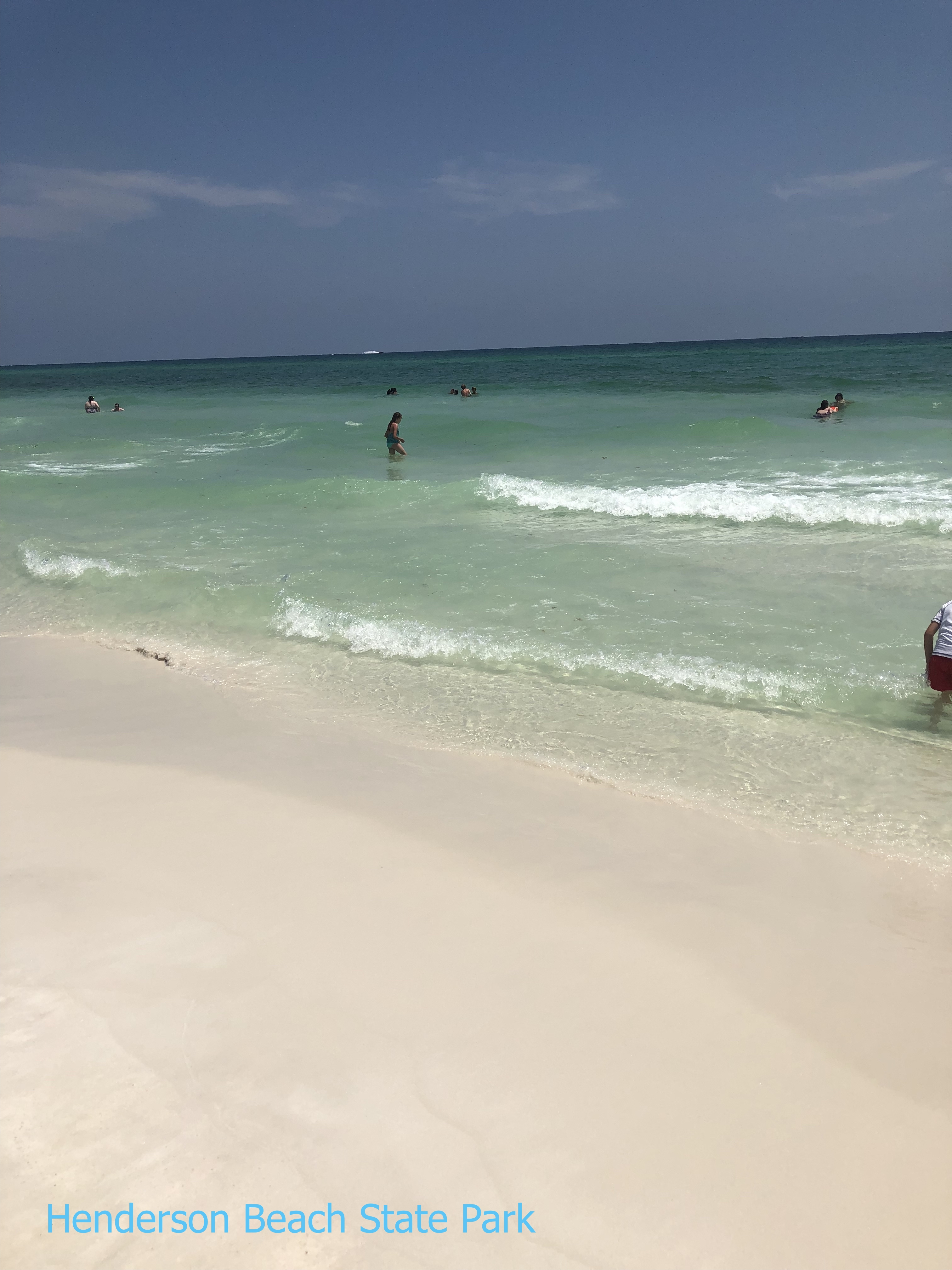
Florida has the longest coastline in the conterminous United States. Its coastline is 1,350 miles (2,170 km) long. More than two-thirds of the coastline is made of sandy beaches. The beaches are quite important, as they are the heart of the local tourism industry.
Florida has over 4,500 islands. The second highest number after Alaska.
Florida has the lowest average topography. The highest point is Britton Hill at 345 feet (105m).
Florida is also home to a large number of lakes. The largest is Lake Okeechobee, also known as Florida's Inland Sea. Many of these lakes are fed by the many beautiful springs scattered throughout the state.
Florida's springs and sinkholes were created by the dissolution of limestone. This is a common rock formation found throughout the state. The limestone is topped with sandy soils.
Florida's Climate
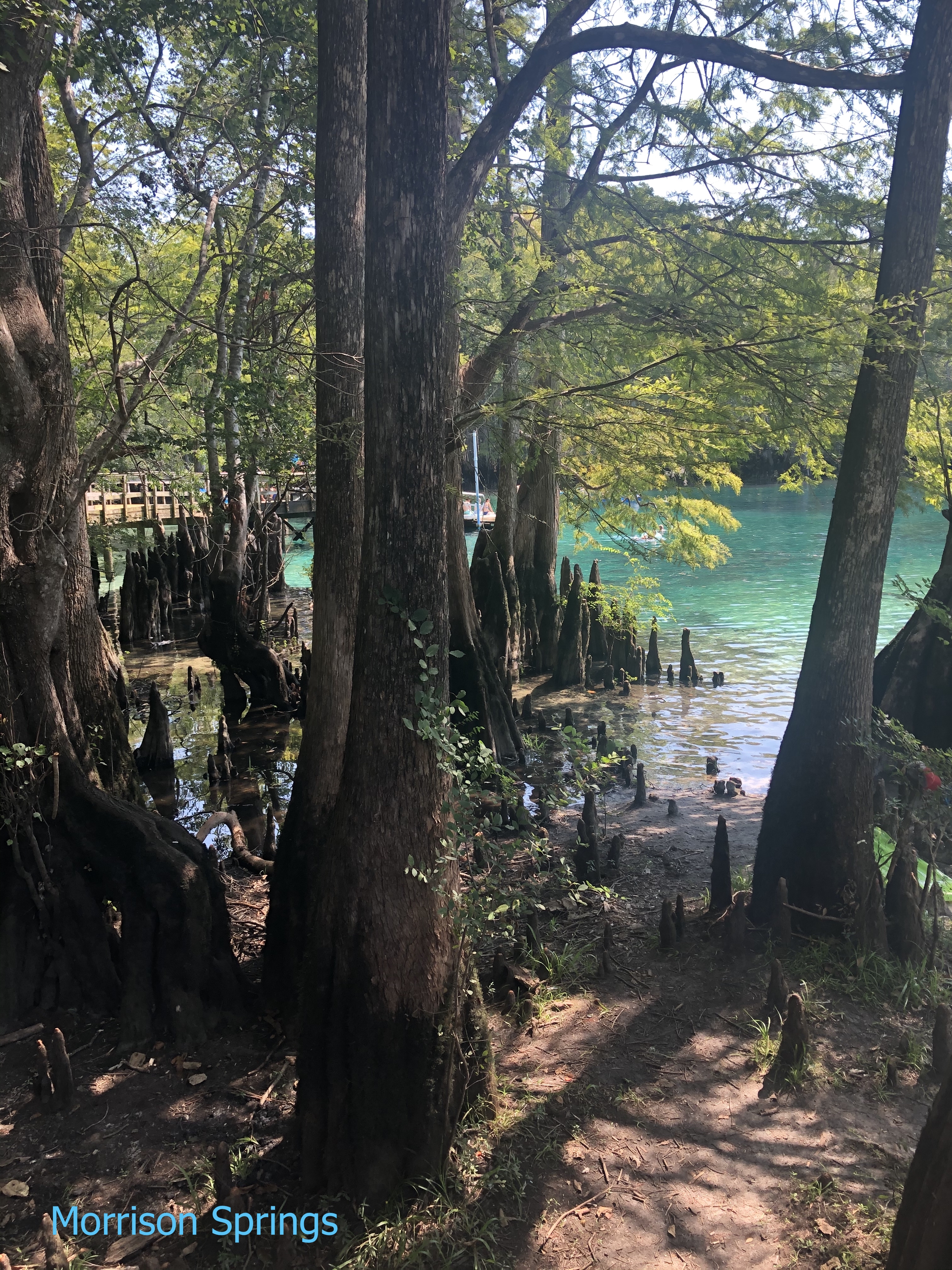
Florida has a temperate climate and does not have marked seasons. Its weather rarely falls below 32°F (0°C). Nevertheless, the weather found in the south of the state is warmer than in the north or Florida panhandle.
Average temperatures in Miami during winter are around 76°F and 85°F in the summer. Pensacola, up north, has average temperatures of 61°F and 83°F in the summer.
Statewide annual average precipitation is 53.7 inches, with more precipitation falling during the warmer months of June through September.
Unfortunately, 40% of all U.S. hurricanes are bound to Florida. This is because of its long coastline and the warm waters surrounding the state.
Florida's Wildlife
Florida has seagrass beds and coral reefs in its coastal waters.
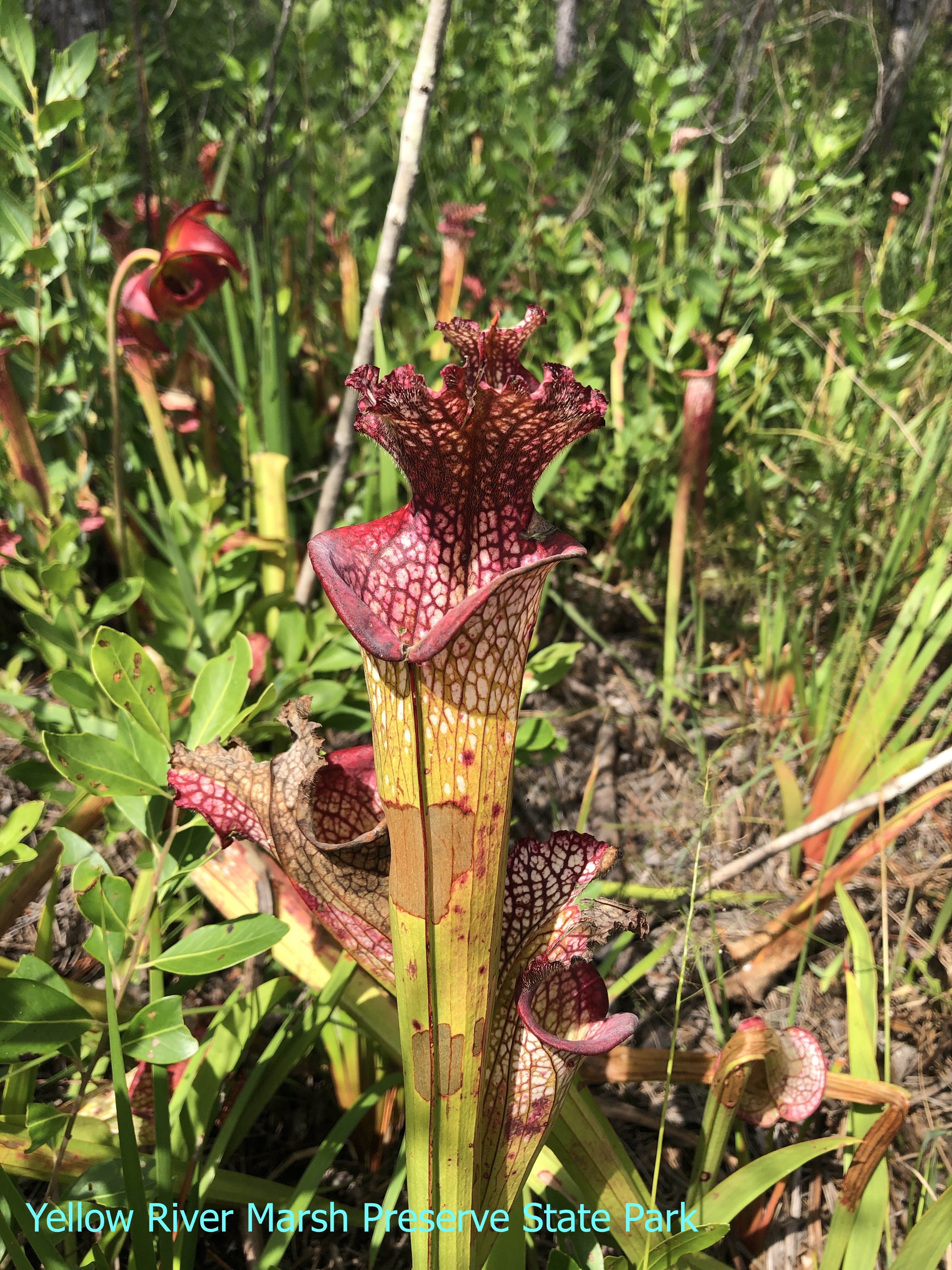
Florida has over 300 types of native trees. In the south, there are mangrove trees. Tall sawgrass is a common sight in marshes as well as cypress. Further north, thanks to its sandy soils, Florida has over 7 native species of pine trees.
Regardless of the many plant species found in the state, the most widely cultivated is the orange tree, and its flower is the state's flower.
Mammals in the state include armadillos, panthers, black bears, manatees, dolphins, and whales.
Reptiles include snakes, crocodiles, alligators, lizards, and sea turtles. Birds include owls, crates, mockingbirds, raptors, northern cardinal, woodpeckers, hawks, herons, and more.
Best Parks in Florida
This list includes National and State Parks. I have included some parks with springs. But for a thorough description of the springs, visit Map of Florida Springs!
Everglades National Park
The Everglades National Park is located on the southern tip of Florida's peninsula, west of Miami Beach.

This is the third largest National Park in the conterminous U.S. and the largest subtropical wilderness in the nation.
The Everglades is a wetland park with a constant stream of water that flows at about 2.5 miles per day. Hence the name "River of Grass".
The park is a birder's paradise. Over 360 species of birds include roseate spoonbill, snowy egret, and limpkin.
While visiting the park, you will definitely spot alligators basking in the sun.
Rare species include the American crocodile, the manatee, and the Florida panther.
Visitors can explore the park's different ecosystems while hiking, biking, kayaking, or on a boat.
Remember, the park has a dry season between November and March and a wet season between April through October. During the wet season, wildlife is dispersed and harder to see. Mosquitoes and biting flies may make your trip a bit uncomfortable, Everglades.
For great hotels in Miami, visit Hotels.com. There are hotels close to the beach or closer to the Everglades. For prices and amenities, click on this link!
Dry Tortugas National Park
Dry Tortugas is offshore, west of Key West in the southern tip of the state. The park is only accessible by boat or seaplane.
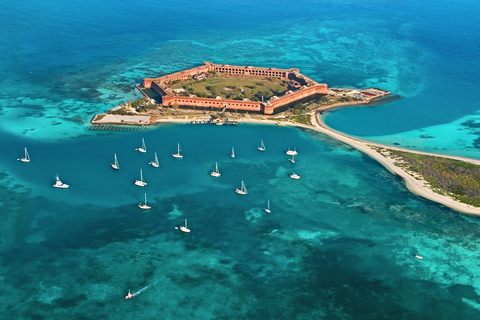
The park is known for Fort Jefferson and its gorgeous blue waters. Visitors don't hesitate to bask in the beautiful white sand beaches and swim in its waters. Less than 1% of the park is dry ground.
The park is part of the Florida Keys reef system, the third largest in the world. Nevertheless, visitors need to remember that beautiful creatures like fire coral, jellyfish, and sea urchins are also dangerous and not to be touched.
Given its location, the main activities at the park are camping, swimming, snorkeling, and diving, Dry Tortugas.
Florida Caverns State Park

Northeast of Panama City is the only dry cave system in the state.
The caves have large underground rooms whose access was enlarged by Civilian Conservation Corps workers in the 1930s. Thanks to their work, it is possible to visit the caverns standing up.
The guided tour takes about one hour. The delicate cave formations are enhanced with colorful lights.
Speleothems are the main attraction for visitors. Speleothems are mineral deposits formed inside caves by the dripping or flowing of water.
The most common forms of Speleothems are stalactites, stalagmites, columns, and flowstone. They take thousands of years to form.
Speleothem shape varies depending on water dynamics and crystal growth of the constituents.
Some of the frequent minerals are calcite, aragonite, and gypsum, all common in Florida; Science Direct.
Other attractions inside the caves are small fossil remains visible in the limestone. You may also see small animals like mice, bats, or salamanders.
Even though it is a small park compared to other state parks, it offers all amenities, including kayaking, equestrian trails, playgrounds, and campgrounds.
Blue Springs State Park
Blue Springs is a small lime area on the map. It is 33 miles (53Km) north of Orlando.
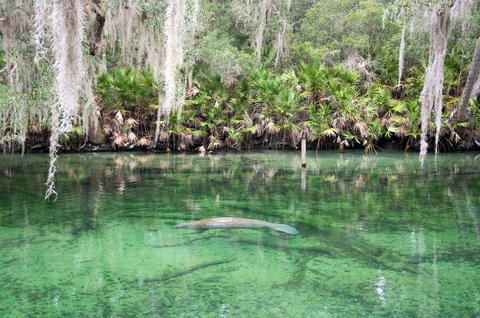
The park has beautiful 72°F (22°C) spring waters that flow to the St. Johns River. Visitors like to swim, snorkel, or float down on a tube. Boat tours and kayaks through the lower section of the spring are also popular activities.
Besides protecting the spring, this park was made to protect the manatees. There are over 700 manatees that come in the spring. Nevertheless, visitors cannot get in the water and disturb them when they are around.
The park has over 140 species of birds, including the Florida scrub Jay, Blackburnian warbler, Mississippi kite, and the chestnut-sided warbler.
The park has a nature trail, picnic pavilions, playgrounds, campgrounds, and more.
Certified divers are welcome to dive in the park.
This is a popular park, so arrive early. When the park reaches capacity, it shuts down.
Bahia Honda State Park
Bahia Honda State Park is located in Monroe County, approximately 120 miles south of Miami and 36 miles east of Key West. Access to the park is by U.S. Highway 1.
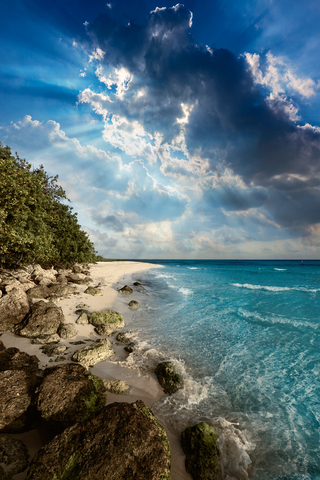
The park includes Bahia Honda Key and Little Bahia Honda Island, which is one-half mile to the southwest and can be accessed only by boat.
The allure of this park is its beautiful beaches and its tropical surroundings. The park has birdwatching, snorkeling, and stargazing, plus campgrounds and usual amenities by the beach.
Besides native plants, corals, fish, and birds, Bahia Honda is an important nesting ground for Sea Turtles!
The park's history was marked by Henry Flagler, who made a Railroad to reach Key West in the early 1900s. The railroad was eventually damaged by an intense hurricane. The remains of the bridge were used to build the Overseas Highway Bahia Honda State Park.
If you plan to spend the night nearby but don't wish to camp, VRBO has the perfect stays. There are over 2,000 vacation rentals in Key West. For locations and availability check this link!
Silver Springs State Park
Silver Springs State Park is west of Ocala, Florida.

Silver Springs is known for the crystal clear springs, tranquil gardens, historic structures, and the glass bottom boats where visitors marvel at the underwater habitat.
The park has several trails where visitors can see wild turkey, white-tailed deer, tortoises, and squirrels.
Because Florida's Geology is integral to understanding the origin of the springs, the park has its own museum with great exhibits and events.
The park offers cabins, campgrounds, a restaurant, an equestrian trail, and other facilities; Silver Springs.
Myakka River State Park
Myakka River State Park is southeast of Sarasota. This is Florida's first designated wild and scenic river.
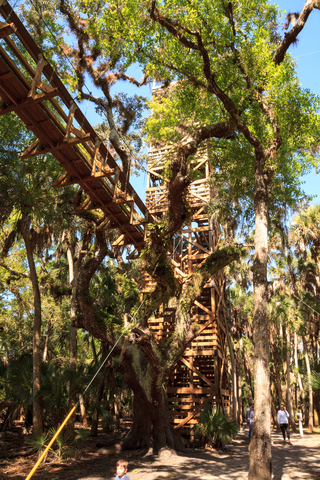
Myakka River State Park is over 37,000 acres of land protecting the Myakka River. This is a fascinating park since it has pristine prairies, wetlands, and pine forests.
There are hawks, vultures, eagles, limpkins, osprey, turtles, and alligators throughout the park.
Tourists love going to the canopy walk. This is North America's first public treetop trail! The trail is 25 feet over the ground, on top of hammock, oak, and palm trees. The course extends for 100 feet.
Travelers can experience the river on canoes, kayaks, and even trails!
Activities include hiking, camping, fishing, boat tours, bicycling, birding, and horseback riding; Myakka.
Manatee Springs State Park
Manatee Springs is west of Gainesville.
The park has a first-magnitude spring with 50 to 150 million gallons of water/day flow. Its waters are crystal clear. You can even see schools of fish and manatees!

Even though manatees are mainly visible in the cooler months, manatees' most significant threat to survival is tourism. Whether it is from boat propellers or from divers and canoes. The best way to decrease their mortality is through public education and awareness campaigns; Manatees and Tourism.
The wildlife visible while swimming or kayaking at the park also includes turtles, birds, alligators, and snakes.
The park has an extensive series of caves and tunnels beneath the springs. There are more than 5 miles of known routes for divers to explore!
Besides water amenities, the park has 800ft of boardwalk along the spring. It is ideal for walking under a canopy of trees and observing wildlife and plants. Other trails will take you to a swamp and ponds. There is no end to what you can see.
Tomoka State Park
Tomoka State Park is South of Jacksonville.
The area was occupied by a large Indian village. Nevertheless, after the first European explorers came, the locals died of the diseases they brought. You can still see mounds of the shells left by their daily catch.
In the 1700s the area was an indigo plantation. You can find the indigo plants throughout the park.
Tomoka is a special place to walk trails and watch birds.
There is biking, hiking, camping, and paddling. There are also boat ramps for boats and canoes to access the river.
Dr. Julian G. Bruce St. George Island State Park
This barrier island is located on the Gulf of Mexico, Southeast of Tallahassee.
George Island offers 9 miles of beaches for relaxing and swimming. One of the most beautiful beaches in Florida!
The park also offers boat ramps to access the bay, and it is possible to kayak and canoe in the shallow areas.
Fishing is quite popular as some catches include flounder, pompano, whiting, redfish, sea trout, and Spanish mackerel.
The park has facilities for family camping and a playground.
Few people know that it is one of the best birding sites in all of Florida. This is especially evident in the fall and winter months.
Some of the birds are Piping Plovers, Snowy Plovers, Least Terns, American Oystercatchers, Gull-billed terns, scissor-tailed flycatchers, Snowy Owl, and the list goes on..... FloridaBirdingTrail.com
There are so many places in Florida to kayak. You might as well take an inflatable with you. Amazon has a One Person Inflatable Kayak Set. It comes with aluminum oars and an air pump. It is ideal for those who like to ride alone. As it is inflatable, it is easy to pack and travel with.
Ginnie Springs
Northwest and not too far from Gainesville is Ginnie Springs.
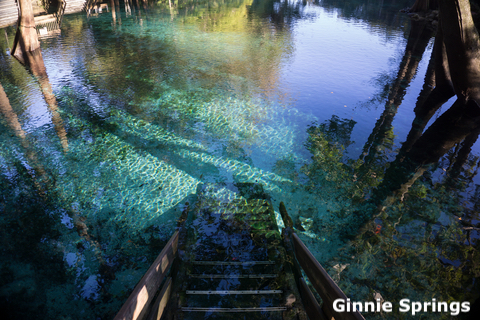
This private park has one of the most transparent waters in Florida. Jacques Cousteau dove into it in 1974 and described it as "visibility forever".
This is a group of springs where you can go swimming, snorkeling, tubing, and diving.
Diving is one of the major attractions as the springs have a cave system and underwater passageways.
The park also offers camping sites throughout its 200 wooded acres. Source: GinnieSpringsOutdoors.com
If you are flying from another state, you can always rent a car with Expedia. Florida is a large state with many incredible sites like Ginnie Springs, where a car is indispensable. For brands and availability, visit this link!
Topsail Hill Preserve State Park
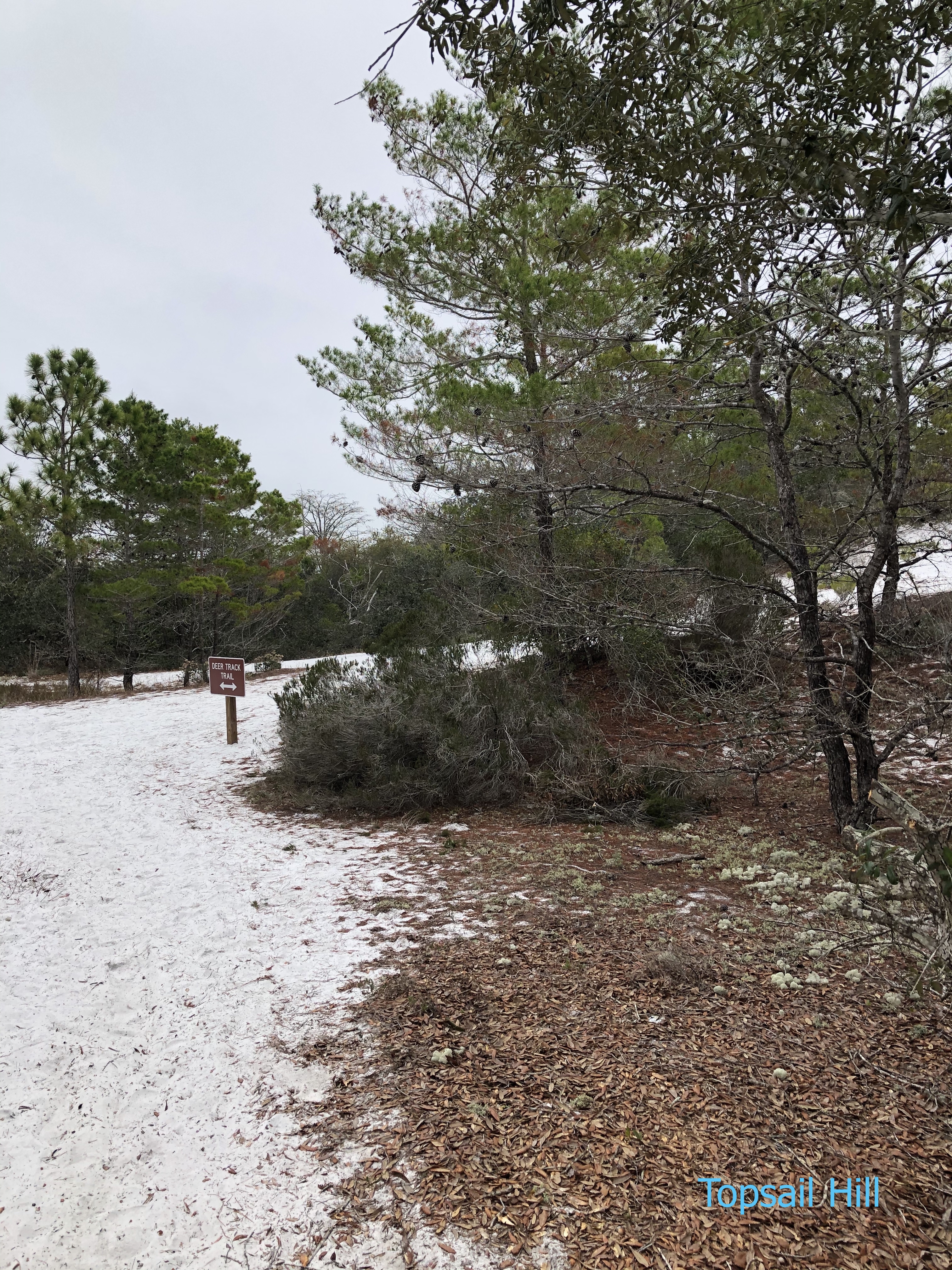
West of Panama City, this park offers 3 miles of white sand beaches on the emerald-colored waters of the Gulf of Mexico.
Topsail has freshwater lakes protected from the Gulf by tall sand dunes. There is an area where you can cross the sand dunes and reach the beach.
On the lakes, it is possible to paddle board or kayak. It is feasible to walk to the lakes, but biking is the best way to reach them.
The park is covered with pine forests and sandy scrubland. It is not rare to see pitcher plants and deer while you take a stroll.
John Pennekamp State Park
Located in Key Largo, it is praised for being the first undersea park.
The park's main attractions are its coral reefs and the life forms around them. These include sea stars, slugs, tunicates, crabs, shrimp, lobsters, manatees, sea turtles, dolphins, and schools of fish.
If you don't know how to scuba dive, it is possible to see these beauties on glass bottom boats.
Because of the park's latitude makes it possible to find mangrove and seagrass areas, vital ecosystems of the Florida Keys.
Families can also go for a swim by the beach and see more sea life in the park's large aquariums.
The park has all sorts of amenities, including boat ramps, campgrounds, playgrounds, pavilions, and parking John Pennekamp Coral Reef State Park.
Lake Louisa State Park
Lake Louisa is just west of Orlando. It is designated as an Outstanding Florida Water Way.
The park has 10 lakes that provide fishing, canoeing, kayaking, swimming, and paddle boarding opportunities.
It is ideal for watching wild communities like white-tail deer, bobcat, fox squirrel, raccoon, gopher tortoise, and the bald eagle.
The park has about 20 miles of unpaved trails, where visitors can see sandhills, swamp forests, creeks, and lakes. All with different wildlife to observe.
Jonathan Dickinson State Park
Jonathan Dickinson is 100 miles north of Miami Beach, close to Jupiter, FL.
The Loxahatchee River is a central part of the park as it is a pristine water body that can be used to explore the rest of the preserve. Named by the Seminole Indians, "Loxahatchee" means River of Turtles.
The park also offers other ecosystems like coastal sandhills, upland lakes, and scrub forests.
The park has the only sand dune in the state tourists can climb, called Hobe Mountain.
About 20 percent of the park is covered in coastal sand pine scrub, a plant so rare it is designated "globally imperiled".
The park has hiking, paddling, biking, horseback riding, picnicking, boat tours, environmental education programs, and campgrounds. Source: JDStatepark.com
Resources for Florida Parks Map

The Shapefiles to make this map of parks were obtained from Florida Natural Areas Inventory.
The shapefiles for cities came from Natural Earth.
This information will also improve with your suggestions. To receive updates on this and more nature maps, join my email list!!!!!!!
Made by Luz K. Molina with D3.js.



